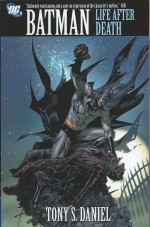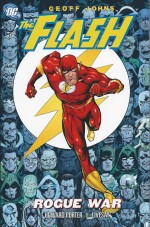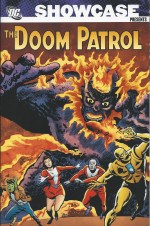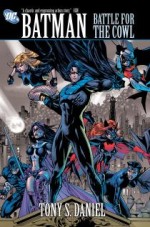
By Tony S. Daniel, Guillem March, Sandu Florea, Norm Rapmund & various (DC Comics)
ISBN: 978-0-85767-123-2
At the climax of a harrowing and sustained campaign of terror by insidious cabal The Black Hand, Batman was apparently killed (by evil New God Darkseid during the “Final Crisisâ€). Although the news was kept from the general public, the superhero community secretly mourned whilst a small dedicated army of assistants, protégés and allies trained over the years by the Dark Knight formed a “Network†of champions to police GothamCity in the catastrophic days and weeks which followed: marking time until a successor could be found…
Most of the Batman-trained task force refuse to believe their inspirational mentor is dead and thus, believing him only lost, have accepted Dick Grayson – first Robin and latterly Nightwing – as the stand-in Gotham Guardian until Bruce Wayne can find his way back to them.
The transition has been bloody and brutal. Grayson had to stop an outcast contender who sought to usurp the legacy of Batman and turn the role of Dark Knight into debased red-handed avenger rather than benign shadowy protector. For now former Robin and erstwhile Red Hood Jason Todd has been defeated, abandoning his quest to become the new Gotham Guardian even as a new iteration of deceased crimelord Black Mask runs rampant in the city.
Crushed and cast aside in the savage gang-war with the triumphant mobster’s mind-controlled False Face Society, mercurial maniac Two-Face has simply vanished, whilst third force The Penguin has been apparently conquered and cowed: remaining only as a meek and compliant vassal of the triumphant newcomer.
Whoever he is, the current Black Mask is as sadistic, psychotic, meticulously methodical and strategically brilliant as his predecessor. His first move had been to free many of Batman’s most maniacal menaces – temporarily stored at Blackgate Prison after the infamous Arkham Asylum was destroyed. Despite the Network’s utmost efforts and the completion of a new high-tech institution, many of the worst inmates remain at large…
This terse and occasionally histrionic volume collects the contents of Batman #692-699 (December 2009 – July 2010) revealing the identity of the mastermind behind the mask and recounting the final fate of the pretender as well as heralding the return of a much misunderstood and fearfully underestimated foe…
Written and primarily pencilled by Tony S. Daniel, the eponymous saga ‘Life After Death’ begins with ‘The Awakening’ (inked by Sandu Florea) as Grayson – grudgingly assisted by Bruce Wayne’s assassin-trained son Damian as the latest Boy Wonder – continues to hunt the escapees and their Machiavellian manipulator…
So great was the crisis that the National Guard had been deployed to enforce Martial Law, driving back the False Face legions and more or less cordoning them into the Devil’s Square area of the city.
With the successor Batman and Police Commissioner Jim Gordon forced to play a waiting game, Black Mask and his inner circle – malignant “Ministry of Science†boffins Fright, Professor Hugo Strange and Dr. Death – go on the offensive by resurrecting a deadly nemesis even as the new director of Arkham seeks a way of undoing the brainwashing techniques used on the False Faces. Hard pressed on all fronts, Grayson seeks the unique assistance of his mentor’s greatest, most secret asset Selina Kyle, and together they discover a new player in the drama. Marco Falcone has returned to Gotham…
Years ago the original Batman had destroyed the power of the Mafia in the city, driving the last of the “Made Men†into exile and breaking the all-pervasive organisation of Carmine “The Roman†Falcone. Now his last surviving son seems intent on using the current chaos to reclaim his inheritance and re-establish the family business…
However the gangster has his own setbacks to deal with: his safe has just been broken into and the contents swiped by Catwoman. As well as cash and jewels the vault contained the most valuable and potentially dangerous document in Gotham…
Luckily for all concerned, Mario doesn’t realise the role his beloved “niece†Kitrina – a very capable and dangerous teenaged cat-burglar in her own right – played in that theft…
The Ministry of Science now has a ferociously hands-on new member. Concentration Camp survivor Dr. Grant Gruener once haunted Gotham as the scythe-wielding vigilante The Reaper, until his apparent demise at the gauntleted hands of the Dark Knight. After years of genetic tampering and behaviour modification by Strange, the killer is back and ready to resume his crusade…
Moreover new information has revealed that the mesmerised False Faces aren’t just enslaved career criminals but also have members recruited from ordinary law-abiding citizens, all equally mind-controlled by the hideous masks they wear – and now someone is killing them, guilty and innocent alike…
The campaign of terror continues as the headstrong and potentially lethal latest Robin joins his barely tolerated commanding officer in winnowing the hordes of False Faces before the pair are distracted by different enemy in ‘Charades’.
Bruce Wayne’s (if not Batman’s) ultimate adversary is Dr. Tommy Elliot, a beloved boyhood friend as warped by his own mother’s malign influence as Bruce was reshaped by the murder of his beloved parents.
Eminent surgeon Elliot became the twisted, sadistic and obsessive Hush to punish his only friend and childhood companion: one who had been perpetually held up to the troubled, never-good-enough kid as a perfect example of a son by Elliot’s deranged parent. Tommy even divined the billionaire’s greatest secret – the true identity of the Dark Knight…
After many deeply personal, psychotic attacks on Wayne’s legacy and Batman’s friends, Hush took the ultimate step in his psychological war against his oldest confidante by surgically transforming himself into Wayne’s mirror image and attempting to entirely usurp his life (see Batman – Streets of Gotham: Hush Money).
The Batman Family had never accepted that their mentor was dead, and all their actions were predicated upon the premise that he would eventually return to reclaim his mantle, so once Catwoman tracked down and emptied all Elliot’s hidden bank accounts Hush began trading on his stolen looks to rebuild his fortune and take another stab at revenge by bankrupting the Wayne financial empire, simultaneously removing the Bat-Network’s crucial operating capital at the same time…
Only recently reformed criminal-turned-High Society Private Eye Edward Nigma – still known as The Riddler – seemed to suspect the imposture, with Grayson and his comrades ironically compelled to publicly cover for the faux Bruce to keep their own secrets…
At a grand benefit to mark the re-opening of Arkham Asylum, Grayson and the undercover Huntress verbally spar with Elliot, Riddler and the Falcones, but when Kitrina perpetrates another robbery Nigma chases her and sustains a life-altering head injury…
Meanwhile in the bloody streets The Reaper is taking a brutal toll on Black Mask’s enemies and the general public too…
Batman begins his fight back by targeting the suspiciously quiescent Penguin in ‘Fractured Pieces’ even as the newly open Arkham begins to suffer mysterious attacks and its builders and administrators begin succumbing to tragic accidents. But even as the Dark Knight’s strategy prompts a murderous attack on the Bird Bandit by Black Mask forces, Mario has discovered Kitrina’s role in his misfortunes and takes steps to end her interference.
Tragically he has completely underestimated her abilities as he hunts for missing maps of Devil’s Square – and Black Mask’s secret sanctum – which she originally created and has now reclaimed…
Norm Rapmund joins Florea on inking with ‘Smoke and Mirrors’ as Kitrina begins her brutal retaliation against the Falcones and Batman discovers who she really is. As Mario flees the aftermath, the mob boss is ambushed by the Reaper and only the last minute intervention of Batman and Huntress save him from a grisly end.
On the deadly, near-deserted streets, Riddler’s confusion slowly abates as he begins making connections to a life he’d forgotten and re-experiences a compulsion long controlled…
The war takes an ugly turn in ‘Mind Games’ when the Penguin at last makes his move: enslaving Batman with Black Mask’s mind-binding gimmicks and dispatching the befuddled crimebuster to even the score – and perhaps even assassinate the murderous mastermind behind everyone’s woes…
By the time Robin has rescued his brainwashed senior partner, Kitrina has found an ally and mentor of her own – one with no love for the Falcones, Penguin or Black Mask and an agenda all her own – and the Boy Wonder’s unsavoury task is to reconstruct just what horrors Batman has committed since he fell under the spell of the mind-controlling mask.
Armed with inevitable conclusions, hard-won knowledge and unpalatable truths regarding presumed friends and foes, the new Dark Knight at last implacably ends the plague of unrest afflicting Gotham but, even after taking out the Ministry of Science, overcoming the rampaging Reaper and exposing Black Mask, the ‘Liberator’ and his Network allies are acutely aware that the job never ends and the battle is barely begun…
This collection then concludes with the 2-part ‘Riddle Me This’ (illustrated by Guillem March & colourist Tomeu Morey) as the Prince of Puzzlers encounters a murderous old associate in criminal conjuror Blackspell whose ‘Magic Tricks’ concealed a cunning, years-long revenge scheme.
However as the bloodshed and mystery escalated in ‘A Means to an End’ the increasingly overworked Batman was forced to accept that the obvious suspect might not be the guilty one… nor that all his allies were working with him…
Torturous, tumultuous, convoluted and challenging, this action-packed, high-octane Fights ‘n’ Tights drama will deliver all the thrills, spills and chill fans could hope for with impressive punch and panache aplenty. Moreover it’s all very, very pretty to look at and even the freshest neophyte is well aware that it’s all just a prelude to the return of the real Dark Knight…
© 2009, 2010 DC Comics. All Rights Reserved.










